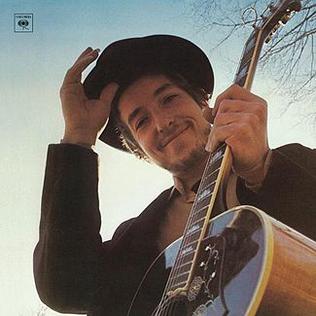
Nashville Skyline is the ninth studio album by American singer-songwriter Bob Dylan, released on April 9, 1969, by Columbia Records as LP record, reel to reel tape and audio cassette.
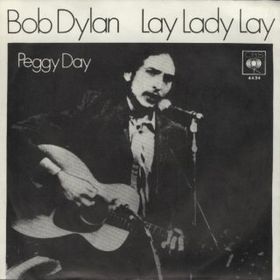
"Lay Lady Lay", sometimes rendered "Lay, Lady, Lay", is a song written by Bob Dylan and originally released in 1969 on his Nashville Skyline album. Like many of the tracks on the album, Dylan sings the song in a low croon, rather than in the high nasal singing style associated with his earlier recordings. The song has become a standard and has been covered by numerous bands and artists over the years.
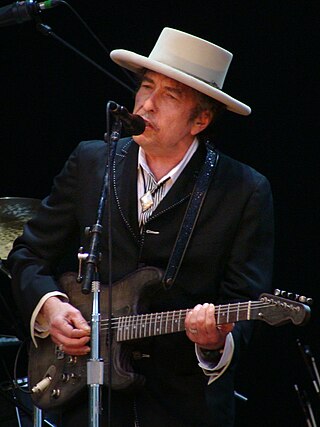
Bob Dylan is an American singer and songwriter. Often regarded as one of the greatest songwriters of all time, Dylan has been a major figure in popular culture during a career spanning more than 60 years. Much of his most celebrated work dates from the 1960s, when songs such as "Blowin' in the Wind" (1963) and "The Times They Are a-Changin'" (1964) became anthems for the civil rights and antiwar movements. His lyrics during this period incorporated a range of political, social, philosophical, and literary influences, defying pop music conventions and appealing to the burgeoning counterculture.

"Rainy Day Women #12 & 35" is a song written and recorded by American singer-songwriter Bob Dylan. Columbia Records first released an edited version as a single in March 1966, which reached numbers two and seven in the US and UK charts respectively. A longer version appears as the opening track of Dylan's seventh studio album, Blonde on Blonde (1966), and has been included on several compilation albums.

"I Want You" is a song by American singer-songwriter Bob Dylan, which was released as a single in June 1966 and on his seventh studio album, Blonde on Blonde, later that month. The song was written by Dylan, and produced by Bob Johnston. The song has been interpreted as a straightforward expression of lust, although critics have highlighted that the symbolism of the song is complex. It was the last song recorded for Blonde on Blonde, with several takes recorded in the early hours of March 10, 1966. It was included on Bob Dylan's Greatest Hits (1967). The song has received a largely positive critical reception, with a number of commentators highlighting for Dylan's use of imagery, although some of the meanings are obscure.
"She Belongs to Me" is a song by Bob Dylan, and was first released as the second track on his 1965 album Bringing It All Back Home. The song may be about a former girlfriend, Suze Rotolo, or fellow folk singer Joan Baez, contemporary siren Nico, or Sara Lownds, the woman that Dylan would wed in November 1965.
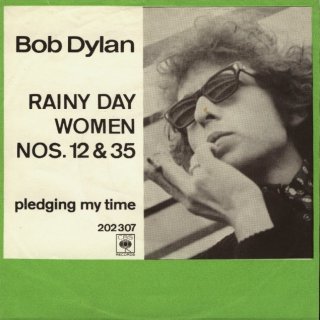
"Pledging My Time" is a blues song by American singer-songwriter Bob Dylan from his seventh studio album, Blonde on Blonde (1966). The song, written by Dylan and produced by Bob Johnston, was recorded on March 8, 1966 in Nashville, Tennessee. Dylan is featured on lead vocals, harmonica, and guitar, backed by guitarist Robbie Robertson and an ensemble of veteran Nashville session men.
"Girl from the North Country" is a song written by Bob Dylan. It was recorded at Columbia Recording Studios in New York City in April 1963, and released the following month as the second track on Dylan's second studio album, The Freewheelin' Bob Dylan. Dylan re-recorded the song as a duet with Johnny Cash in February 1969. That recording became the opening track on Nashville Skyline, Dylan's ninth studio album.
"To Ramona" is a song by American singer-songwriter Bob Dylan, first released on his fourth studio album, Another Side of Bob Dylan (1964). The song was written by Dylan, and produced by Tom Wilson. The lyrics were started at the May Fair Hotel in London in May 1964, and finished during a week-long stay in the Greek village of Vernilya later that month. Dylan recorded all the tracks for the album, including the song, in a single three-hour session on June 9, 1964, at Studio A, Columbia Recording Studios, New York. Its narrator advises Ramona, who is preparing to return to "the South", not to follow the advice of others. Critics have suggested several different people as inspirations for the song, including Joan Baez, Suze Rotolo, and Sara Lownds.
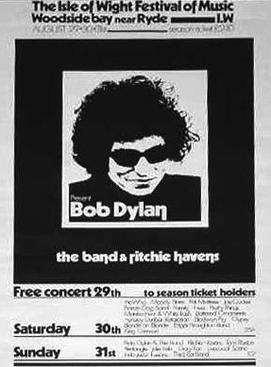
The 1969 Isle of Wight Festival was held on 29–31 August 1969 at Wootton Creek, on the Isle of Wight. The festival attracted an audience of approximately 150,000 to see acts including Bob Dylan, the Band, the Who, Free, Joe Cocker, the Bonzo Dog Band and the Moody Blues. It was the second of three music festivals held on the island between 1968 and 1970. Organised by Rikki Farr, Ronnie and Ray Foulk's Fiery Creations, it became a legendary event, largely owing to the participation of Dylan, who had spent the previous three years in semi-retirement. The event was well managed, in comparison to the recent Woodstock Festival, and trouble-free.

"If Not for You" is a song by American singer-songwriter Bob Dylan from his October 1970 album New Morning. It was also issued as the A-side of a single in Europe in early 1971. The song is a love song to Dylan's first wife, Sara Dylan. He recorded it several times in 1970; the session for the released version took place in New York in August. He also recorded the song with George Harrison on May 1, soon after the break-up of the Beatles, a session that attracted much speculation in the music press. The May recording remained unreleased until its inclusion on The Bootleg Series Volumes 1–3 in 1991.
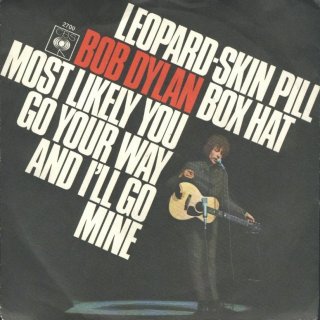
"Most Likely You Go Your Way and I'll Go Mine", or "Most Likely You Go Your Way (and I'll Go Mine)", is a song by American singer-songwriter Bob Dylan. It was released as the first track on side three of his seventh studio album Blonde on Blonde (1966). The song was written by Dylan and produced by Bob Johnston. Dylan recounted that he had probably written the song after the end of a relationship. The song's narrator criticizes the lies and weakness of a woman, and says that he finds it hard to care. The final verse establishes that the woman has been unfaithful to the narrator by having a relationship with another man, as he suspected all along.

"Tonight I'll Be Staying Here with You" is a song written by Bob Dylan from his 1969 album Nashville Skyline. It was the closing song of the album. The song was the third single released from the album, after "I Threw It All Away" and "Lay Lady Lay", reaching #50 on the US Billboard Hot 100 chart, and reaching the top 20 in other countries. It was anthologized on the compilation albums Bob Dylan's Greatest Hits Vol. II and Playlist: The Very Best of Bob Dylan '60s.
Bob Dylan bootleg recordings are unreleased performances by American singer-songwriter Bob Dylan, that have been circulated throughout the public without undergoing an official, sanctioned release. It is commonly misconceived that bootlegs are only restricted to audio, but bootleg video performances, such as Dylan's 1966 film Eat the Document, which remains officially unreleased, are considered to be bootlegs. Dylan is generally considered to be the most bootlegged artist in rock history, rivaled only by the Grateful Dead.
"I'd Have You Anytime" is a song written by George Harrison and Bob Dylan, released in 1970 as the opening track of Harrison's first post-Beatles solo album, All Things Must Pass. The pair wrote the song at Dylan's home in Bearsville, near Woodstock in upstate New York, in November 1968. Its creation occurred during a period when Harrison had outgrown his role in the Beatles and Dylan had withdrawn from the pressures of fame to raise a family. "I'd Have You Anytime" is recognised as a statement of friendship between the two musicians, whose meetings from 1964 onwards resulted in changes in musical direction for both Dylan and the Beatles. The song reflects the environment in which it was written, as Harrison's verses urge the shy and elusive Dylan to let down his guard, and the Dylan-composed choruses respond with a message of welcome.
"To Be Alone with You" is a country-rock song by American singer-songwriter Bob Dylan, released as the third track on his 1969 album Nashville Skyline.
"John Wesley Harding" is a song by American singer-songwriter Bob Dylan that appears as the opening track on his 1967 album of the same name.
"Behind That Locked Door" is a song by English rock musician George Harrison from his 1970 triple album All Things Must Pass. Harrison wrote the song in August 1969 as a message of encouragement to Bob Dylan, who was making a highly publicised comeback to the concert stage, accompanied by the Band, with a headlining performance at the Isle of Wight Festival. "Behind That Locked Door" is a rare Harrison composition in the country music genre and the second song dealing with the friendship between himself and Dylan, after their 1968 collaboration "I'd Have You Anytime". Its lyrics address Dylan's elusive nature, and reflect the high regard in which Harrison held the American singer's work. The same reluctance on Dylan's part to re-engage with a concert audience led to him retreating again from live performance until August 1971, when he responded to Harrison's request to play at the Concert for Bangladesh.

The Bootleg Series Vol. 10: Another Self Portrait (1969–1971) is a compilation album by American singer-songwriter Bob Dylan, released on August 27, 2013 on Legacy Records. The eighth installment of the ongoing Bob Dylan Bootleg Series, it consists of unreleased recordings, demo recordings, alternative takes mostly from Dylan's 1970 albums Self Portrait and New Morning, and two live tracks from the 1969 Isle of Wight Festival.
"I Pity the Poor Immigrant" is a song by American singer-songwriter Bob Dylan. It was recorded on November 6, 1967, at Columbia Recording Studios, Nashville, produced by Bob Johnston. The song was released on Dylan's eighth studio album John Wesley Harding on December 27, 1967.











